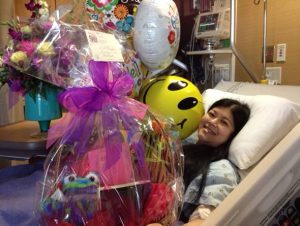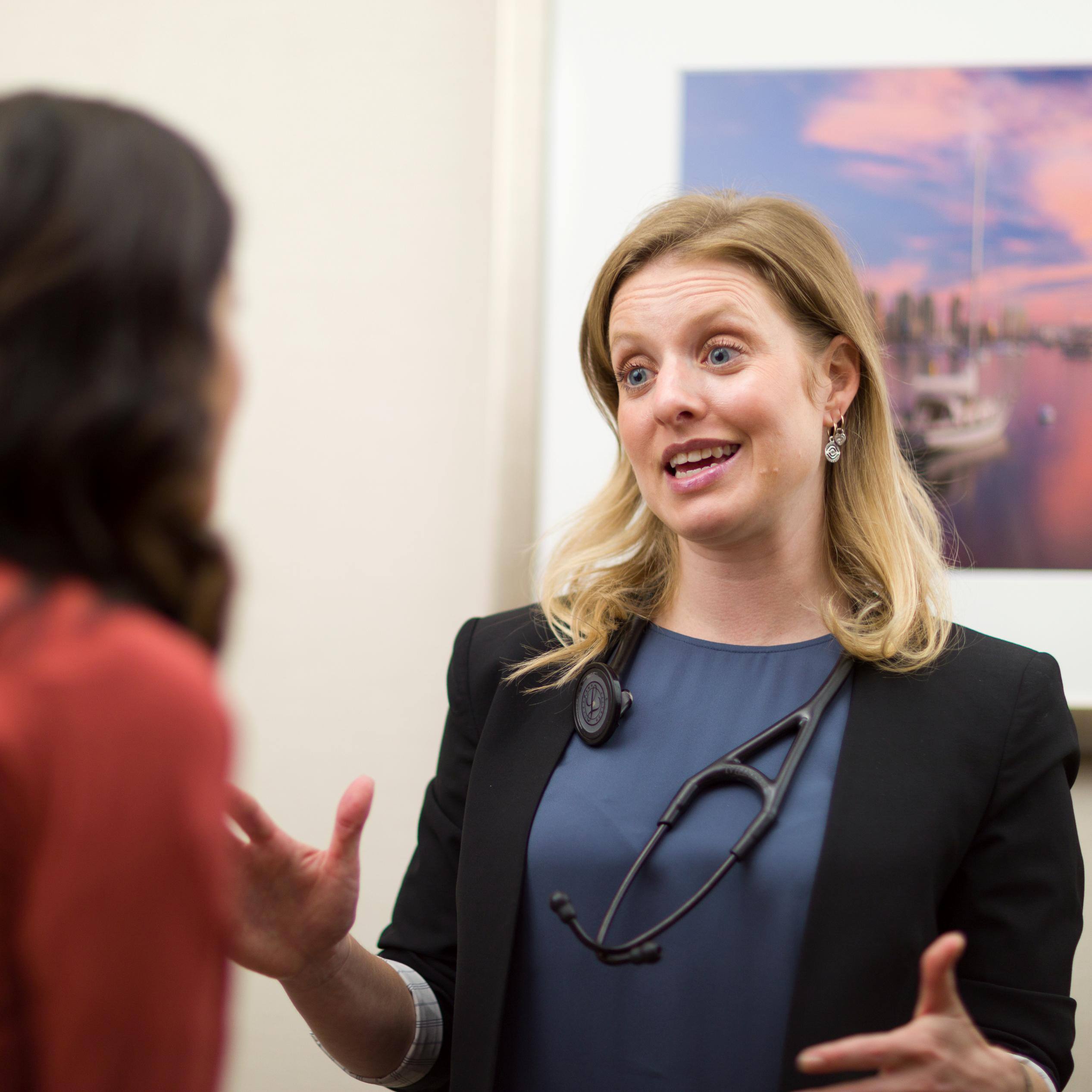-
Personal journey shapes unique perspective

When Linda Hasadsri, M.D., Ph.D. (they/them/she/her), began a Mayo Clinic fellowship in Clinical Molecular Genetics immediately after completing their training in Clinical Biochemical Genetics, they never imagined the genetic tests they were helping develop would be the very same tests that guided their life’s journey. But just after starting that fellowship, Dr. Hasadsri’s personal and professional worlds collided, giving them a dual role as both patient and physician.
Now the director of the Molecular Technologies Laboratory in the Department of Laboratory Medicine and Pathology and proud mom to two sons, Dr. Hasadsri’s experiences provide a unique perspective on the quality of Mayo Clinic Laboratories testing, the importance of timing, and the implications of test results for the future.
“WHEN I SAY A GENETIC TEST IS THE BEST TEST OUT THERE YOU COULD GET FROM THE BEST PEOPLE, I KNOW IT FROM MY OWN EXPERIENCE — I’M NOT JUST HYPING IT UP BASED ON SOME PERFORMANCE METRICS,” DR. HASADSRI SAYS. “I ACTUALLY WENT THROUGH THE PROCESS AND COULD TELL YOU ALL THE THINGS A TEST DOES WELL AND WHAT INFORMATION IT CAN YIELD FOR YOU.”
Back in 2012, Dr. Hasadsri was working through an intense laboratory fellowship. Newly married and pregnant, their life took an unexpected turn when they miscarried the pregnancy. The devastating event triggered a sequence of medical discoveries that saved Dr. Hasadsri’s life and placed them on a genetic testing track that enabled the family of their dreams.
“If that pregnancy and pregnancy loss had not happened, I would not have gotten my cancer diagnosis, I would not have been stage 3 — I would’ve been stage 4. Literally, that baby that never was saved my life.”
Up close and personal with genetic testing
Despite their young age and having no known family history of cancer, Dr. Hasadsri was found to have stage 3 colorectal cancer. A sample of the tumor tissue underwent somatic testing (current Mayo ID: MCCRC). Much to Dr. Hasadsri’s surprise, the results came back suggestive of Lynch syndrome, a hereditary cancer predisposition syndrome, and a blood sample was submitted for follow-up hereditary testing (current Mayo ID: LYNCP). Advanced sequencing to detect gene variants related to Lynch syndrome, which increases the risk of colon, endometrial, uterine, and other cancers, yielded no pathogenic variants.
The negative test result was the first of many Dr. Hasadsri has received in the past decade. Each result informing their choices and providing reassurance that nothing has been missed. Moreover, the ability to experience each existing and newly implemented oncology test in the lab has provided unique insight into what answers mean to patients.
“IT WAS AN UNREAL EXPERIENCE TO BE TRAINED ON THE TESTS THAT I MYSELF WAS EXPERIENCING — IT REALLY LEVELS UP YOUR LEARNING,” DR. HASADSRI SAYS. “WITH EACH NEW TEST OR TECHNOLOGY THAT WAS LAUNCHED, I WOULD HAVE IT BECAUSE WE WERE TRYING TO SEE WHETHER I HAVE A MOLECULAR EXPLANATION FOR THIS CANCER, EITHER HEREDITARY OR ACQUIRED, BECAUSE EITHER WAY I WOULD HAVE AN ANSWER THAT COULD HELP ME PREPARE OR PLAN MY LIFE ACCORDINGLY.”
Navigating health challenges
For Dr. Hasadsri, the miscarriage marked the beginning of an ongoing testing journey. Just after the loss, blood testing revealed a hemoglobin level of five grams per deciliter (g/dL) of blood. The average hemoglobin in adult females is 12–15 g/dL.
“(My primary care physicians) were like, ‘This is not conducive to a successful pregnancy, and we need to get to the bottom of this,’” explains Dr. Hasadsri.
Due to a known family history of alpha-thalassemia, Dr. Hasadsri was sent to hematology to determine whether an underlying anemia was at play. While suspected hematologic culprits were being discussed, the hematology-oncology fellow performing the physical exam found an abdominal mass.
“The whole time I was feeling exhausted from what turned out to be anemia and having some abdominal pain after eating meals, I'd never even thought to examine myself,” Dr. Hasadsri says. “And then once I actually felt that area of my abdomen, I could definitely palpate it as well. I could push around it and feel my lymph nodes were enlarged too. And so that got me worried.”
Although cancer was within the differential diagnosis, it was not something Dr. Hasadsri easily accepted. “I’m like, ‘maybe I just have really bad inflammatory bowel disease and my colon is just really angry and hardened from that.’”
CT imaging revealed the mass had penetrated two sections of the colon, causing internal bleeding and a low hemoglobin level. Neighboring lymph nodes were also enlarged. During a follow-up colonoscopy, part of the mass was removed and biopsied. Somatic tumor testing revealed features of Lynch syndrome, an inherited cancer predisposition syndrome, but germline testing did not identify any causative genetic variants.
Female colon cancer patients who test positive for Lynch syndrome are at an increased risk of developing uterine, endometrial, endothelial, and gastric cancers, among others.
“If an individual with Lynch syndrome is diagnosed with colon cancer and has a uterus in place, we typically remove the uterus (hysterectomy), fallopian tubes, and ovaries at the time of colon cancer surgery, unless the individual has not completed childbearing,” says Myra Wick, M.D. Ph.D., Dr. Hasadsri’s OB/GYN and medical geneticist. “This reduces cancer risk and the need for additional surgeries in the future.”
The pending nature of Dr. Hasadsri ’s molecular test result at the time they were scheduled to undergo a hemicolectomy, combined with their knowledge that Lynch syndrome diagnosis can only be cemented through molecular genetic testing, empowered them to push back against the recommended surgical approach.
“I remember during the consent process before going into surgery, they were saying, ‘You have Lynch syndrome — we should remove your uterus and ovaries too,’’’ Dr. Hasadsri says. “And I was like ‘WAIT! I still want those, I’m not done with those yet.’”
So the uterus and ovaries stayed. But 75% of Dr. Hasadsri’s colon and more than 30 lymph nodes were removed.
Defying the odds to build a family

After the surgery, Dr. Hasadsri and their spouse, Vincent Pureza, M.D., Ph.D., faced another decision. Because the chemotherapy needed to target any lingering cancer cells would push Dr. Hasadsri into premature menopause and limit their ability to bear genetic offspring, did they want to undergo in vitro fertilization and preserve embryos so they could one day try for the family they still hoped for?
In the end, the answer was yes. Thanks to a grant from the Livestrong Foundation, the couple successfully created and froze five embryos.
Immediately after the egg retrieval, Dr. Hasadsri began chemotherapy. Over the course of six months — all while still training as a Mayo Clinic fellow — they received 12 rounds of treatment.
“I was told that after chemo, you should probably wait at least a year before trying to get pregnant, because all of those harmful chemicals are still in your body. We don't know what effect they're going to have on the eggs, on a potential embryo, or pregnancy,” Dr. Hasadsri says. “And chemo definitely put me in menopause. But just to be safe I also went on birth control afterwards too, because I was like, I’m not going to take any chances.”

But just one month after chemotherapy ended, the unimaginable happened: Dr. Hasadsri conceived naturally.
“My OB/GYN, who is also a medical geneticist, was happy but also a little freaked out. It was too soon,” Dr. Hasadsri says.
“It is always concerning when women become pregnant in the midst of cancer treatment,” Dr. Wick says. “We're not always sure if there will be implications for the pregnancy,” Dr. Wick says. “We don’t know if some of the treatment the patient is on currently or previously might affect fetal growth or be associated with congenital problems. So, Dr. Hasadsri’s pregnancy soon after chemotherapy placed them into a high-risk pregnancy category, where we monitor things more carefully, including the baby's growth.”
The pregnancy, however, was successful, and so was the delivery.
“And that's how my 7-year-old came into being,” Dr. Hasadsri says.
Three years later, after using the frozen embryos and enduring three pregnancy losses, Dr. Hasadsri had accepted their fate.
“It was like, OK, I guess one child’s enough, I’m perfectly happy to have this one miracle baby that I didn’t even think I would have,” they say. “But then I got naturally pregnant with my second at age 40. I feel very lucky.”
Proactively managing diagnosis
Throughout their medical journey, Dr. Hasadsri has followed the screening and testing recommendations for individuals with Lynch syndrome, despite lacking a genetic diagnosis.
“Even though I still carry a Lynch syndrome diagnosis in my chart, it’s because they would rather err on the conservative side and make sure I am managed appropriately, which I am totally on board with,” Dr. Hasadsri says. “I’d rather be screened more often than less since, even if I were eventually found not to have Lynch, I still worry about my risk of a cancer recurrence.”
That translates into annual colonoscopies. Before having their second son, Dr. Hasadsri also received annual endometrial biopsies. Not long after the baby was born, Dr. Hasadsri underwent a hysterectomy and oophorectomy.
“I’M GETTING TO NOT JUST WITNESS THE PROGRESS BEING MADE IN GENETIC TESTING OF TUMORS AND FOR HEREDITARY CANCER PREDISPOSITION SYNDROMES BUT GETTING TO PERSONALLY EXPERIENCE IT AT THE SAME TIME, WHICH IS INCREDIBLE,” DR. HASADSRI SAYS. “BY HAVING TESTING DONE, I GOT TO ACTUALLY SEE HOW IT PERFORMED AND WHEN THOSE TESTS BECAME CLINICALLY LIVE AND AVAILABLE TO ALL PATIENTS, I KNEW FROM TRULY PERSONAL EXPERIENCE HOW FANTASTIC THOSE TESTS WERE.”
As the sensitivity and specificity of genetic sequencing have increased and genetic targets become more defined, it is possible that a genetic association with Lynch syndrome will eventually be discovered for Dr. Hasadsri. But to date, each new test has yielded negative results.
“I am definitely an example of how sometimes a negative result is just as powerful and just as relieving as a positive one,” Dr. Hasadsri says. “Or that it inches you a bit more toward closure. It's still very, very gratifying and satisfying because you're like, ‘OK, that's just one more piece of evidence that it's probably not something that I inherited or that my kids could inherit from me.’”
Translating experience into action
While Dr. Hasadsri’s interest in genetic testing evolved long before their personal journey intersected with hereditary cancer testing, the experience has fueled their passion.
“Just recently we had an example of a potentially difficult diagnosis with a pregnant patient, it was a condition that is tested for in our laboratory, and Dr. Hasadsri really went the extra mile to test additional family members and send tests kits out,” Dr. Wick says. “I think that is just part of their personality and how they function, and illustrated meeting the needs of the patients and going all out to make sure that happens.”
Having felt the many emotions that correspond with cancer testing, Dr. Hasadsri understands deeply what is at stake for patients seeking answers.
“EVERY PATIENT DOES HAVE A LAB TEST AT SOME POINT, AND SO I THINK THAT LABORATORY MEDICINE AND PATHOLOGY IS ESPECIALLY RELATABLE FOR THE PEOPLE WHO WORK IN THE FIELD,” DR. HASADSRI SAYS. “BUT IN MY CASE, I FEEL LIKE IT WAS EXTRA REAL BECAUSE I WAS THAT PATIENT GOING THROUGH THAT PROCESS ANXIOUSLY WAITING. IF IT’S AT THE END OF THE DAY AND YOU’VE GOT AN EXTRA CASE, FOR INSTANCE, YOU WANT TO TAKE THE TIME TO GET THE CASE OUT, EVEN THOUGH IT’S STILL WITHIN TURNAROUND TIME AND COULD WAIT UNTIL THE NEXT DAY, YOU DON’T BECAUSE YOU KNOW WHAT IT MEANS TO BE THAT PATIENT. BECAUSE YOU WERE THAT PATIENT.”
This article first appeared on the Mayo Clinic Laboratories blog.







